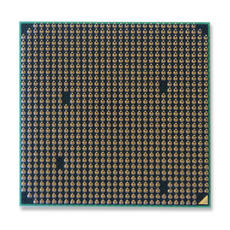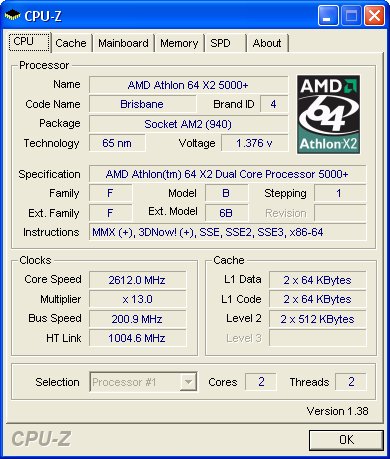AMD ATHLON 64 X2 5000+ BRISBANE REVIEW BENCHMARK AND OVERCLOCKING
![]()
|
|
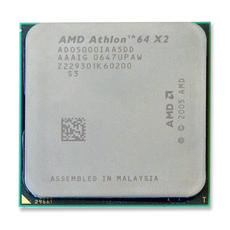 |
|||||||||||||||||||||||||||||||||||||||||||||||||||||||||||||||||||
| Posted:2007-01-10 By cpu review Number of View:103265 |
||||||||||||||||||||||||||||||||||||||||||||||||||||||||||||||||||||
By :cpu review Posted:2007-01-10
When AMD launched last May its platform AM2, the firm of SunnyVale also benefitted from the launch of its first processors Energy Efficient. Profiting from initials EE, these Athlon 64 was distinguished from other models range by thermal type (or TDP) witch was lower . In the end of this year , the arrival of first processors AMD profiting from 65 Nm, makes possible to AMD to give on front its range of processors Energy Efficient, but not as clearly as he could have wished . the four new models Athlon 64 X2 made in 65nm. With four new processors made in 65 Nm and integrating the new Brisbane core, AMD tries to prove that its existance vs INTEL Core 2 Duo.
AMD passes to the 65nm with four new models… to start!
Arrival of Brisbane coreWith regard to the core even processor, AMD gives a successor in the middle Windsor which currently animates Athlon 64 X2 AM2 with the Brisbane coree. the new, beautiful, this core introduces some significant changes to start with a new management of the multiplying coefficients. Thus, the Brisbane processors are not limited any more to the only oldcoefficients and Athlon 64 X2 4400+ 65 Nm will employ a multiplying coefficient of 11,5x against 11x for the same processor in 90 Nm. In fact, this model has a frequency of 100 MHz higher than its equivalent in 90 Nm, but it compensates by quantity lower cache memory divided by two (2x 512 KB instead 2x 1 Mb). It will be noted that usually AMD compensated with the Rating of memory in the second level by a stage frequency of 200 MHz: So with the processors 65 Nm there is no model equipped with 2x 1 MB L2 cache. The fault certainly with the problems of release… On the four new processors 65 Nm launched by AMD, only the model 5000+ preserve characteristics identical to its equivalent in 90 Nm.Another not less valuable change by AMD: the latency times for memory . According to our tests, the latency time of the L1 remains identical to that in processors 90 Nm but the latency of the memory in the second level was increased ! Although AMD tries to minimize the impact of increase in the latency , evoking in the worst case degradation of 1% in the performances, this change would have in impact in applications which depend particularly on memory acess time. Here the latency times of the memory raised under CPU-Z:
The founder justifies his choice by explaining that the increase in the latency times should in the long term result in to increase in the memory in the seconde level.
AMD Athlon 64 X2 5000+ EE and electric consumption
Side operating temperatures, the processor core is more reasonable since our 65 Nm showed only 52° C in full load against 62° C for its equivalent 90 Nm. We record here temperature of CPU in the BIOS after long toture torture test under Prime95. OverclockingWe of course want to check the behavior of new processors AMD in 65 Nm when it is a question of overclocking. For that we had recourse to the same platform as in benchmarks, The motherboard Asus m2 N32-SLI Deluxe. DDR2 Corsair 6400 at the price of a reduction in the memory ratio to go up with high frequency. We have without too much effort reached the 3 GHz, or more exactly 3025 MHz with a bus of 275 MHz and with the help of an adjustment of the multiplying coefficient: 11x against 13x default. We also took care to arrange the various parameters offered by BIOS like the supply voltages processor and memory, but also the chipset voltage as well as the multiplying coefficient of the bus HyperTransport in order to return the system bootable. Beyond, 3 GHz and with our standard cooling we alas could not obtain a stable system.In comparison, with old Athlon 64 X2 5000+ 90 Nm we have about the same results in overclocking what tends to indicate that the 65 Nm does not improve really the difficult task of overclocker K8 architecture already pushed to its limit. 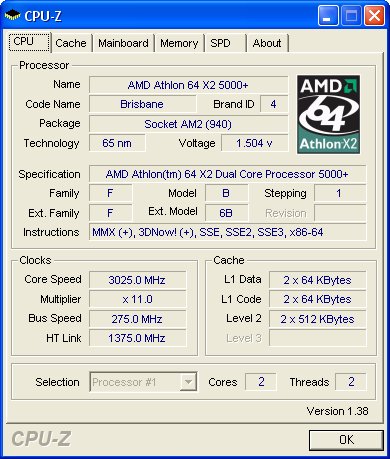
Physically identical to its pars, Athlon 64 X2 is a processor dual core being presented at the format Socket AM2. It is thus made in 65 Nm and account according to AMD a little more than 153 million transistors. With a coefficient of 11x and a frequency operation 2,6 GHz, the chip has 2x 512 KB in the second level and 2x 128 KB L1 cache in each core. Our test processor was provided with the stepping G1 Brisbane core, stepping compatible with a great number of motherboard even if a BIOS update can sometimes be necessary. Note however that our m2 N32-SLI Deluxe started perfectly with this Athlon 64 X2 65nm in spite of its rather old BIOS. AMD made state of a TDP of 65 Watts maximum what remains very correct, even if the TDP of first Athlon 64 X2 EE is identical. The passage to the 65 Nm thus does not make possible to improve this parameter, unless the founder is not particularly preserving in the data which it communicates. To test the performances of the last baby AMD we had recourse to the platform whose detail appears below:
We will oppose all this small world to Core 2 Duo INTEL who were tested on the following platform:
3DMark 06 - CPU - v1.1.0
PCMark 05 - CPU - v1.2.0
PCMark 05 - Memory - v1.2.0Centered exclusively on the memory, the test of the same PCMark 05 gives the advantage to Core 2 Duo E6600. If until now our two Athlon 64 X2 5000+ posted relatively close in performances! The model made in 65 Nm falls in bottom of classification, just in front of Core 2 Duo E6300 with performances in fall of 9% at equal frequency! Blow, Athlon 64 X2 4600+ EE is shown more powerful than the 5000+ 65 Nm which makes here less although than Core 2 Duo E6400. Sandra Xi - Processor Test
Sandra Xi - Memory test
Athlon 64 and their controller integrated continue to make the happiness of Sandra: processors AMD being largely in front of their opponents INTEL. The difference between Athlon 64 X2 5000+ made in 90 Nm and Athlon 64 X2 5000+ EE in 65 Nm reaches here a little more than 2% and extremely curiously, Athlon 64 4600+ EE is at the head. ScienceMark 2.0 - PrimordiaThis good ScienceMark old man continues to go in favor of Athlon 64 X2. However, old X2 5000+ made in 90 Nm is shown more powerful than the new model 65 Nm: the variation here is about 5%. Core 2 Duo E6600 is thus in equality with Athlon 64 X2 5000+ 65 Nm whereas Athlon 64 X2 4600+ EE service better than Core 2 Duo E6400 and E6300: it is 24% faster here than Core 2 Duo E6300. Cinebench 9.5
Adobe Photoshop CS 2.0We benefit from the new year to adopt version 2.0 Photoshop CS. The occasion to change our test to use this time the filter radial blur, a multi-threaded filter. We measure time necessary to the application of this filter on an image with resolution 2.048 X 3.072. the results are expressed in second,. Surprised, Athlon 64 X2 5000+ 90 Nm makes here better than Core 2 Duo E6600. Photoshop CS 2 confirms the loss of performances generated by the passage to the 65 Nm since 65nm cpu loses here more than three seconds in the application of filter. Core 2 Duo E6300 and E6400 being slower than Athlon 64 X2 4600+ EE. Windows Media Encoder 9.0Here, we measure the time put by each one of our systems to compress a video at the origin format AVI. The results are expressed in seconds:. Core 2 Duo E6300 and Athlon 64 X2 4600+ EE take practically a minute more to encode our video vs Core 2 Duo E6600. This last is at the head and Core 2 Duo E6400 finishes second, in front of Athlon 64 X2 5000+. The penalty generated by the passage to the 65 Nm at AMD is painless here: Athlon 64 X2 5000+ Windsor and Brisbane being with equality. Files Compression WinRAR 3.62the results are expressed here in seconds. Core 2 Duo dominate the exercise whereas the passage to the 65 Nm does not seem definitely a succes in Athlon 64 X2 5000+ with Brisbane core it is ten seconds slower than Windsor core in 90 Nm… 3DSMax 8 - Radiosity
TMPGenc 4.0
Studio 10.7we have done here the compression with format MPEG 4 bitrate 6 Mb/S. the results is expressed in seconds. Core 2 Duo E6600 is once again the fastest processor whereas Core 2 Duo E6300 and Athlon 64 X2 4600+ EE close again the ball. There difference in performances between Athlon 64 X2 made in 90nm and 65nm, the small last-born from AMD being slower than its elder at equal frequency. Mathematica 5.1Mathematica go in favor of Core 2 Duo E6600 which is once more first, followed-up there with Core 2 Duo E6400. The higher latency times of Brisbane core 65 Nm penalize here slightly the Athlon 64 X2 5000+ whereas Core 2 Duo E6300 is slightly in withdrawal vs Athlon 64 X2 4600+ EE. Doom 3 v1.3 - 1024x768x32Doom 3 shows us that the game seems particularly limited by the graphics card, all our processors being almost with equality. Core 2 Duo E6600 as usually take the lead whereas Athlon 64 X2 5000+ 65 Nm shows a loss by three fps / second vs the model made in 90 Nm. Far Cry v1.4 - 1024x768x32For Far Cry Core 2 Duo E6400 and E6600 make the difference here. The platform Core 2 Duo E6400 is thus 10% faster than the system Athlon 64 X2 5000+. Although the game confirms the loss of performances related to the passage in 65 Nm with fps . Call Of Duty 2 - v1.3 - 1024x768x32We finish this series of tests with Call Duty 2 which is particularly favorable to Core 2 Duo. Our three processors INTEL occupy the first three podium position whereas . X2 5000+ 90 Nm is once again faster than its equivalent 65 Nm with a difference in performances approximately 5%! ConclusionYou will have understood that the arrival of the smoothness 65 Nm is done definitely in the pain of AMD. After having known many delays on the development of this process,amd propose finally a processor to us which has equal frequency is less powerful than its predecessors! Thus Athlon 64 X2 5000+ in 90 Nm is shown faster than the new model made in 65 Nm and equipped with the Brisbane core! The fault is due to the increase in the latency times of L2 memory … As for overclocking, the arrival of 65 Nm really does not seem to facilitate the things .
we would be happy to answer for your question . if you have suggestion or comment
regarding this review our support would be glad to help just join our forum and ask u will get the best answer
to discuss check our forum section :-) RATE THIS REVIEW | ||||||||||||||||||||||||||||||||||||||||||||||||||||||||||||||||||||
![]()

AMD Athlon 64 X2 5000+ Brisbane review benchmark and overclocking
AMD Athlon 64 X2 5000+ Brisbane review benchmark and overclocking


7600gt review
7600gt is the middle card range.
We already benchmarked this video card and found that ...

 geforce 8800gtx and 8800gts
geforce 8800gtx and 8800gts  Xtreview software download Section
Xtreview software download Section  AMD TURION 64 X2 REVIEW
AMD TURION 64 X2 REVIEW  INTEL PENTIUM D 920 , INTEL PENTIUM D 930
INTEL PENTIUM D 920 , INTEL PENTIUM D 930  6800XT REVIEW
6800XT REVIEW  computer hardware REVIEW
computer hardware REVIEW  INTEL CONROE CORE DUO 2 REVIEW VS AMD AM2
INTEL CONROE CORE DUO 2 REVIEW VS AMD AM2  INTEL PENTIUM D 805 INTEL D805
INTEL PENTIUM D 805 INTEL D805  Free desktop wallpaper
Free desktop wallpaper  online fighting game
online fighting game  Xtreview price comparison center
Xtreview price comparison center 

- The new version of GPU-Z finally kills the belief in the miracle of Vega transformation
- The motherboard manufacturer confirms the characteristics of the processors Coffee Lake
- We are looking for copper coolers on NVIDIA Volta computing accelerators
- Unofficially about Intels plans to release 300-series chipset
- The Japanese representation of AMD offered monetary compensation to the first buyers of Ryzen Threadripper
- This year will not be released more than 45 million motherboards
- TSMC denies the presentation of charges from the antimonopoly authorities
- Radeon RX Vega 64 at frequencies 1802-1000 MHz updated the record GPUPI 1B
- AMD itself would like to believe that mobile processors Ryzen have already been released
- AMD Vega 20 will find application in accelerating computations
- Pre-orders for new iPhone start next week
- Radeon RX Vega 57, 58 and 59: the wonders of transformation
- ASML starts commercial delivery of EUV-scanners
- The older Skylake processors with a free multiplier are removed from production
- Meizu will release Android-smartphone based on Helio P40
- AMD Bristol Ridge processors are also available in American retail
- The fate of Toshiba Memory can be solved to the next environment
- duo GeForce GTX 1080 Ti in GPUPI 1B at frequencies of 2480-10320 MHz
- New Kentsfield overclocking record up to 5204 MHz
- Lenovo released Android-smartphone K8



computer news computer parts review Old Forum Downloads New Forum Login Join Articles terms Hardware blog Sitemap Get Freebies

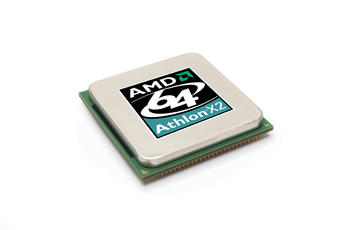
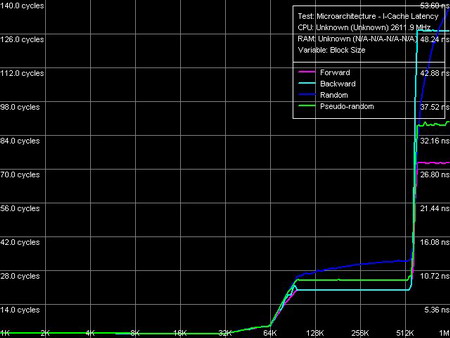

 Until now, INTEL was the only manufacturer of processors using 65 Nm and this since… Pentium D! On its side, AMD had remained faithful to 90 Nm even if the situation became hard getting in the limit of their processors. So the passage to smoothness lower technical process makes possible to the founder to increase his production. A processor more smoothness occupies less place on silicon wafer . One can thus put more processors in A wafer. In facts, the core of new Athlon 64 X2 65 Nm measures a little more than 126 mm ² against 183 mm ² for its predecessor. Other favors generally related to the improvement of the process : are less heating and lower power consumption .
Until now, INTEL was the only manufacturer of processors using 65 Nm and this since… Pentium D! On its side, AMD had remained faithful to 90 Nm even if the situation became hard getting in the limit of their processors. So the passage to smoothness lower technical process makes possible to the founder to increase his production. A processor more smoothness occupies less place on silicon wafer . One can thus put more processors in A wafer. In facts, the core of new Athlon 64 X2 65 Nm measures a little more than 126 mm ² against 183 mm ² for its predecessor. Other favors generally related to the improvement of the process : are less heating and lower power consumption .
